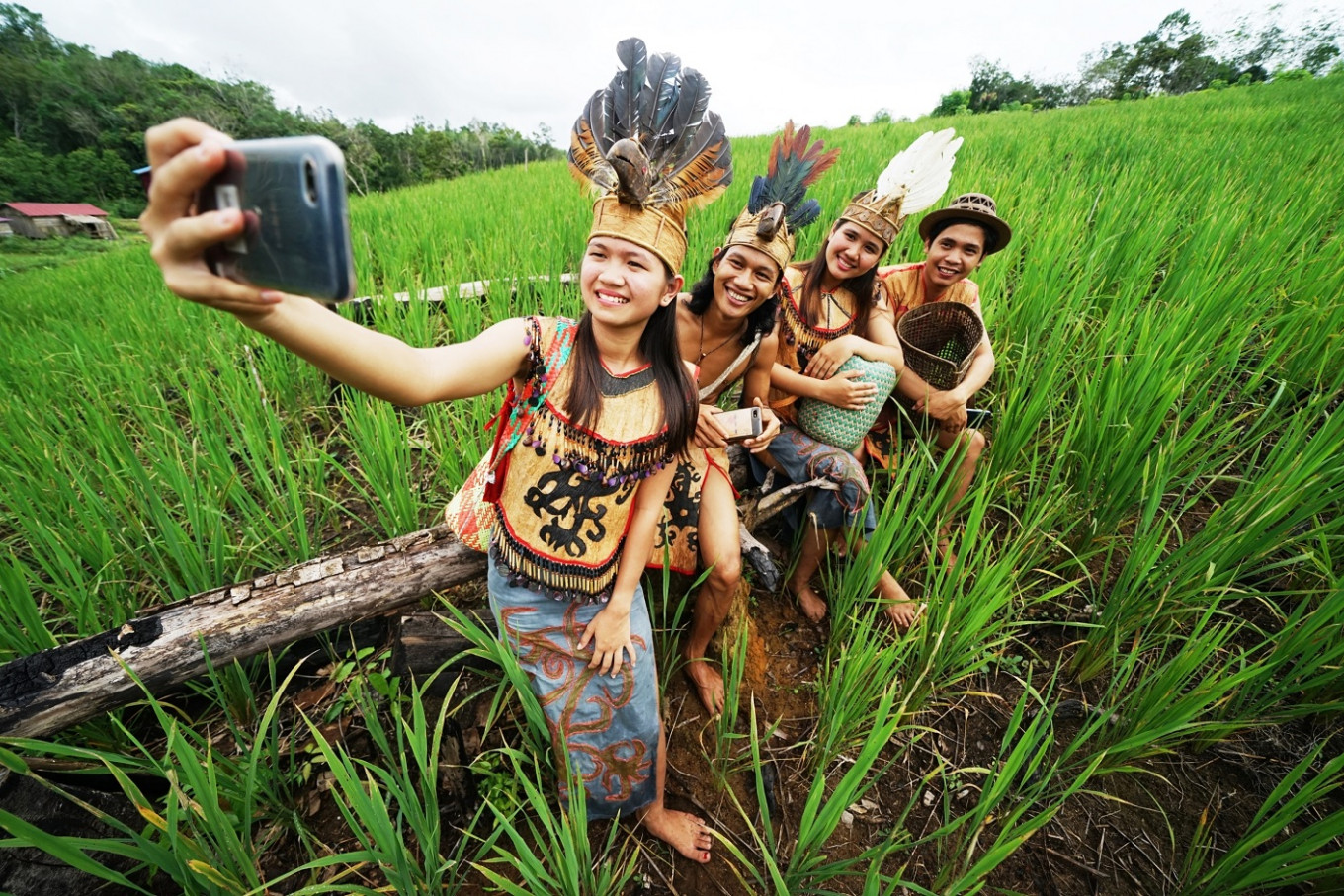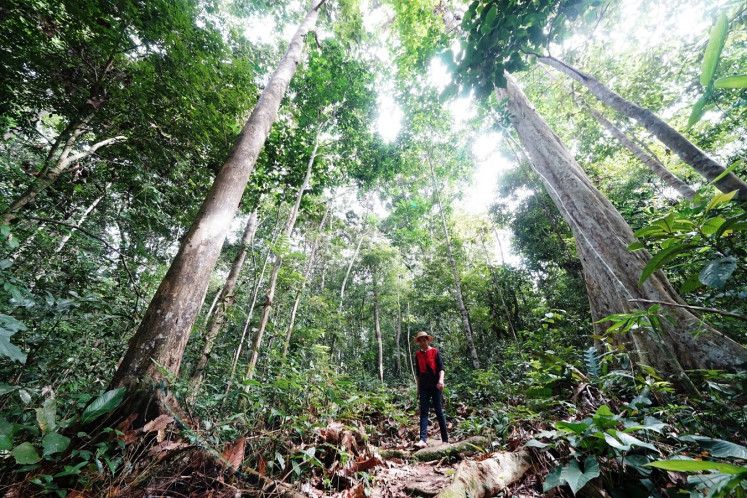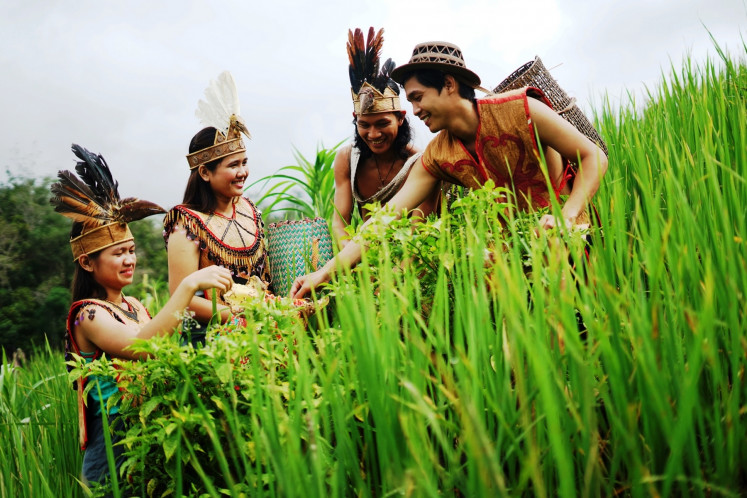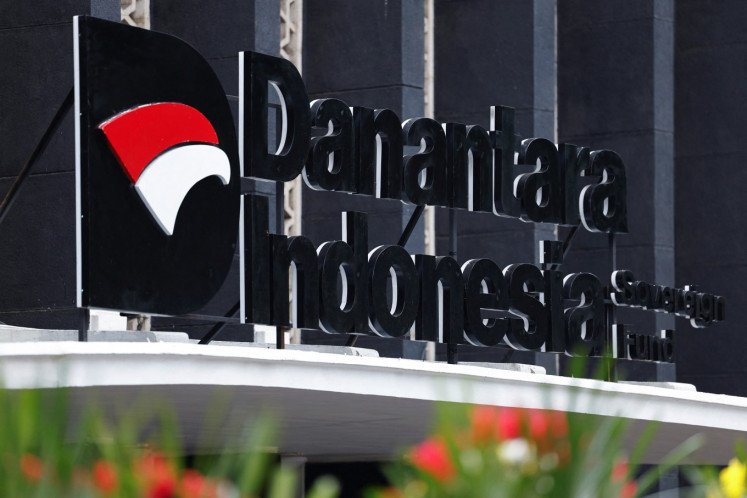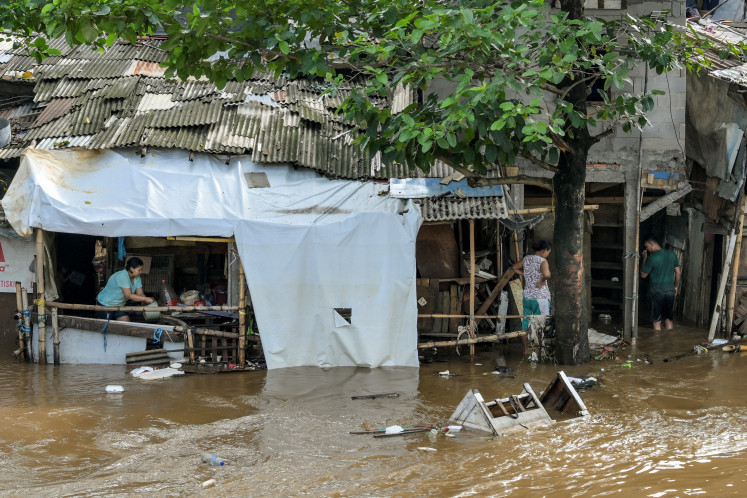Popular Reads
Top Results
Can't find what you're looking for?
View all search resultsPopular Reads
Top Results
Can't find what you're looking for?
View all search resultsYoung Dayaks continue their cultural legacy
Change text size
Gift Premium Articles
to Anyone
Young Dayaks consider technology the perfect tool to celebrate and preserve their cultures and traditions.
Dwi Ayu Dahlia, a 19-year old Dayak girl from Sanjan village in Sanggau regency, West Kalimantan, uses her cell phone mostly for recording footage and taking photographs. Unlike her contemporaries in Java, she seldom uses her phone for browsing due to the lack of internet access in her village.
“Signal is hard to get here, only in certain places. And even if you do, it’s not always 4G, let alone 4G+,” she said.
In the morning of Jan. 12, Ayu was already in the Tomawankng Ompu’ communal forest. In the middle of the 237-hectare forest, Ayu took selfies in various poses typical of young people of her age with her head slightly tilted and two fingers held up.
The Tomawankng Ompu' communal forest. (JP/Syafrizaldi Jpang)On her way into the forest, Ayu also recorded videos of nature in the vicinity. The communal forest will soon be developed into a natural tourist zone for education. She was accompanied by her father, Petrus, along the way.
Petrus said he helped Ayu learn many things from local resources and wanted the children of Sanjan to become keen learners and reliable people in the future.
“Learning from nature is one way of building children’s character,” said Petrus.
Petrus acquainted Ayu with different forest fruits. They found durian and savored the tasty fruit while taking several more fruits to be eaten together in a forest hut.
Ayu and her father belong to the Dayak Kodatn Sebiau community, a sub-ethnic group of Dayak Bidayuhik. The other well-known sub-ethnic Dayak group is the Ibanik.
The Dayak Kodatn Sebiau people in Sanjan are now participating in the development of the Tomawankng Ompu’ communal forest into a natural tourist location. The forest is not too far from the center of Sanggau regency and is opportunely located.
“From Sanggau, it is only 17 kilometers away. From Pontianak [the capital city of West Kalimantan], where I often stay, the distance is almost 230 kilometers,” said Ayu.
Petrus also introduced some medicinal plants to Ayu and some teenagers who were talking about trees.
“A tree enables many creatures to live, from those nesting in roots and soil to birds benefiting from branches and twigs. Fruits and flowers provide food for birds, bees and squirrels,” explained Petrus.
According to Petrus, the cycle of life begins from the earth, water and air that support the lives of trees. When the trees grow, they help maintain the soil humidity because sunlight is absorbed by the forest canopy instead of directly falling on the forest floor.
Some of the teenagers had heard Petrus’ description in school, but they gained a great deal of new knowledge that day.
“I’m going to invite my campus friends to study medicinal herbs here,” said Ayu, who is also a medical student at the Tanjungpura University, Pontianak.
The forest was first managed in 1930. Its special designation was established by the Sanjan customary authority, which called on local residents to protect the forest and prohibited its reclamation for farming.
“In 1953, its boundaries were delineated. Local people have known the exact area of the communal forest,” said Petrus. This forest is part of the Kodatn Sebiau communal zone, stretching along the tributaries of the Sekayam River.
In a village east of Sanggau, the same passion was shared by 18-year old Ifnasia “Untet” Riska. The teenager, who wore clothes made of bark during her interview, believed that young Dayak people should not be ashamed of wearing traditional attire and accessories.
The clothes worn by Untet were a follow-up to a youth meeting that took place in Ansok village in Sintang regency, West Kalimantan. Attendees were determined to revitalize the culture and customs of the people of Dayak Seberuang Ansok.
“We’ve just formed a youth group called the Seberuang Ansok Traditional Youth Movement,” she said.
Untet’s village is inhabited by the Dayak Seberuang ethnic group, about 78 kilometers from the hub of Sintang regency. The Dayak Seberuang people spread from the Seberuang River area in Kapuas Hulu regency. Their ancestors moved many times before reaching the Tempunak River.
“There are no written records. We follow the history told by village elders,” she added.
Dayak Seberuang is part of the Dayak Ibanik group. Ansok village is among the oldest in Tempunak Hulu district. Formerly it was the seat of the administration of Temenggung Udap, the regional chief.
Green space: Some members of the Seberuang Ansok Traditional Youth Movement. (JP/Syafrizaldi Jpang)Ansok village, according to Untet, covers 1,173 hectares, of which 119 hectares are divided into two communal forests, one is Emperkak Hill and the other is Lamat Hill. The name Emperkak refers to a hill that was a tembawang (settlement) in the past.
Untet’s uncle Timotius said the younger generation should be more familiar with natural potential for village development in the future.
“The tembawang is a settlement with old plantations already abandoned. It’s also scientifically known as an agroforest,” added Timotius.
The initiatives of traditional communities in Untet’s and Ayu’s villages are in response to the Constitutional Court’s Decree No.35/PUU-X/2012 on communal forests.
“Our program is supported by the Indigenous Peoples Alliance of the Archipelago [AMAN]. The program aims to recognize communal zones and promote organic farming, sources of livelihood and conservation,” said Ayu.
AMAN Program Director Mirza Indra said Sintang regency had even issued a bylaw on the recognition and protection of customary institutions and traditional communities.
“This bylaw should be implemented because it’s the first in West Kalimantan Barat,” said Mirza.
Traditional communities, according to Mirza, are recognized through identification by district chiefs, village heads and other parties. Then, the regent of Sintang forms a verification and validation committee, whose final decision serves as the basis for the regent to determine the communal zones of the communities.
AMAN and other supporting parties have from the start promoted this bylaw through frequent dialogues since 2013.
“When communal zones are already acknowledged, AMAN hopes the villages of Untet, Ayu and other Dayak people can be more independent in managing their natural resources,” said Mirza.
Untet and Ansok residents are engaged in cultivating 22,040 coffee seedlings. In Sanjan, Ayu’s village, at least 7,000 coffee seedlings are available. All the seedlings will be planted from March to June this year. In Ansok, coffee plants were first introduced by the Dutch, as evidenced by the many old plants in tembawang.
Besides coffee, Ansok women have also learned paddy cultivation in irrigated fields. Previously, said Untet, Ansok people cultivated paddies once a year on farmland. In the fields, paddy production in Ansok is expected to increase so that they no longer need to buy rice.
The activity in Tomawankng Ompu’ is getting more concrete with Ayu encouraging and promoting the involvement of higher educational institutes in research work. She is determined to care for Dayak customs through her medical science studies.
In Ansok, Untet is eagerly tending to the flourishing paddies. She is set to join the traditional women in their efforts to preserve Dayak culture. Click, her smart phone sounds and she cannot help but taking a selfie.

